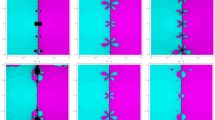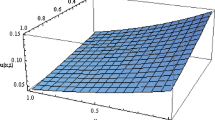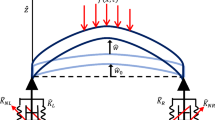Abstract
Due to the considerable complexity of meshfree approximants, there still lacks a rational theoretical estimate on the frequency accuracy of lumped mass meshfree methods. In this study, a detailed theoretical analysis is presented for the lumped mass Galerkin meshfree formulation with particular reference to the frequency accuracy. The proposed accuracy analysis is quite general and is fully based upon the reproducing or consistency conditions of meshfree shape functions and their gradients. The theoretical findings reveal that there exists an important and interesting odd/even basis degree discrepancy feature for the frequency accuracy, i.e., (p + 2)th and (p + 1)th order accurate frequencies are attained by the lumped mass Galerkin meshfree formulation using even and odd degrees of basis functions, where p is the degree of basis function employed in the meshfree shape function construction. Furthermore, it is found that interpolatory meshfree shape functions are capable of not only circumventing the non-physical modes arising from the lumped mass Galerkin meshfree formulation using the standard non-interpolatory shape functions, but also elevating the frequency accuracy for meshfree structural vibration analysis. Numerical examples well replicate the theoretical frequency accuracy analysis results for lumped mass Galerkin meshfree methods.































Similar content being viewed by others
References
Nayroles B, Touzot G, Villon P (1992) Generalizing the finite element method: diffuse approximation and diffuse elements. Comput Mech 10:307–318
Belytschko T, Lu YY, Gu L (1994) Element free Galerkin methods. Int J Numer Methods Eng 37:229–256
Liu WK, Jun S, Zhang Y (1995) Reproducing kernel particle methods. Int J Numer Methods Fluids 20:1081–1106
Atluri SN, Shen S (2002) The meshless local Petrov–Galerkin (MLPG) method. Tech Science, Los Angeles
Li S, Liu WK (2004) Meshfree particle methods. Springer, Berlin
Zhang X, Liu Y (2004) Meshless methods. Tsinghua University Press & Springer, Beijing
Nguyen VP, Rabczuk T, Bordas S, Duflot M (2008) Meshless methods: A review and computer implementation aspects. Math Comput Simul 79:763–813
Liu GR (2009) Meshfree methods: moving beyond the finite element method, 2nd edn. CRC Press, Boca Raton
Chen JS, Hillman M, Chi S (2017) Meshfree methods: progress made after 20 years. J Eng Mech-Asce 143:04017001
Garg S, Pant M (2018) Meshfree methods: a comprehensive review of applications. Int J Comput Methods 15:1830001
Rabczuk T, Song J, Zhuang X, Anitescu C (2019) Extended finite element and meshfree methods. Academic Press, Cambridge
Suchde P, Jacquemin T, Davydov O (2023) Point cloud generation for meshfree methods: an overview. Arch Comput Methods Eng 30:889–915
Liu WK, Jun S, Li S, Adee J, Belytschko T (1995) Reproducing kernel particle methods for structural dynamics. Int J Numer Methods Eng 38:1655–1679
Chen JS, Pan C, Wu CT, Liu WK (1996) Reproducing kernel particle methods for large deformation analysis of nonlinear structures. Comput Methods Appl Mech Eng 139:195–227
Belytschko T, Tabbara TM (1996) Dynamic fracture using element-free Galerkin methods. Int J Numer Meth Eng 39:923–938
Rabczuk T, Areias PMA, Belytschko T (2007) A meshfree thin shell method for non-linear dynamic fracture. Int J Numer Meth Eng 72:524–548
Liu GR, Dai KY, Lim KM, Gu YT (2002) A point interpolation mesh free method for static and frequency analysis of two-dimensional piezoelectric structures. Comput Mech 29:510–519
Liew KM, Ng TY, Zhao X, Reddy JN (2002) Harmonic reproducing kernel particle method for free vibration analysis of rotating cylindrical shells. Comput Methods Appl Mech Eng 191:4141–4157
Li H, Wang Q, Lam KY (2004) Development of a novel meshfree Local Kriging (LoKriging) method for structural dynamic analysis. Comput Methods Appl Mech Eng 193:2599–2619
Bui TQ, Nguyen MN, Zhang C (2011) A moving Kriging interpolation-based element-free Galerkin method for structural dynamic analysis. Comput Methods Appl Mech Eng 200:1354–1366
Wang D, Lin Z (2010) Free vibration analysis of thin plates using Hermite reproducing kernel Galerkin meshfree method with sub-domain stabilized conforming integration. Comput Mech 46:703–719
Wang D, Song C, Peng H (2015) A circumferentially enhanced Hermite reproducing kernel meshfree method for buckling analysis of Kirchhoff–Love cylindrical shells. Int J Struct Stab Dyn 15:1450090
Wu J, Wang D, Lin Z (2018) A meshfree higher order mass matrix formulation for structural vibration analysis. Int J Struct Stab Dyn 18:1850121
Wang B, Lu C, Fan C, Zhao M (2021) A meshfree method with gradient smoothing for free vibration and buckling analysis of a strain gradient thin plate. Eng Anal Bound Elem 132:159–167
Chen JS, Wu C, Yoon S, You Y (2001) A stabilized conforming nodal integration for Galerkin mesh-free methods. Int J Numer Methods Eng 50:435–466
Duan Q, Gao X, Wang B, Li X, Zhang H, Belytschko T, Shao Y (2014) Consistent element-free Galerkin method. Int J Numer Meth Eng 99:79–101
Wang D, Wu J (2019) An inherently consistent reproducing kernel gradient smoothing framework toward efficient Galerkin meshfree formulation with explicit quadrature. Comput Methods Appl Mech Eng 349:628–672
Baek J, Schlinkman RT, Beckwith FN, Chen JS (2022) A deformation-dependent coupled Lagrangian/semi-Lagrangian meshfree hydromechanical formulation for landslide modeling. Adv Model Simul Eng Sci 9:1–35
Jiang W, Gao XW (2023) Analysis of thermo-electro-mechanical dynamic behavior of piezoelectric structures based on zonal Galerkin free element method. Eur J Mech A Solids 99:104939
Zhang Q, Nguyen-Thanh N, Li W, Zhang A, Li S, Zhou K (2023) A coupling approach of the isogeometric-meshfree method and peridynamics for static and dynamic crack propagation. Comput Methods Appl Mech Eng 410:115904
Wang D, Zhang H (2014) A consistently coupled isogeometric-meshfree method. Comput Methods Appl Mech Eng 268:843–870
Zhang H, Wu J, Wang D (2015) Free vibration analysis of cracked thin plates by quasi-convex coupled isogeometric-meshfree method. Front Struct Civ Eng 9:405–419
Zhang H, Wang D (2017) Reproducing kernel formulation of B-spline and NURBS basis functions: a meshfree local refinement strategy for isogeometric analysis. Comput Methods Appl Mech Eng 320:474–508
Hughes TJR (2000) The finite element method: linear static and dynamic finite element analysis. Dover Publications, Mineola
Zienkiewicz OC, Taylor RL, Zhu J (2015) The finite element method: its basis and fundamentals, 7th edn. Amsterdam, Elsevier
Voth T, Christon TM (2001) Discretization errors associated with reproducing kernel methods: one-dimensional domains. Comput Methods Appl Mech Eng 190:2429–2446
You Y, Chen JS, Voth TE (2002) Characteristics of semi-and full discretization of stabilized Galerkin meshfree method. Finite Elem Anal Des 38:999–1012
Voth T, Wang D, Chen JS (2002) An analysis of stabilized integration, Galerkin meshfree discretizations for advection problems. In: Proceedings of the 5th world congress on computational mechanics, Vienna, Austria, July 7–12
Wang D, Lin Z (2011) Dispersion and transient analyses of Hermite reproducing kernel Galerkin meshfree method with sub-domain stabilized conforming integration for thin beam and plate structures. Comput Mech 48:47–63
Wang D, Lin Z (2012) A comparative study on the dispersion properties of HRK and RK meshfree approximations for Kirchhoff plate problem. Int J Comput Methods 9:1240015
Park CK, Wu CT, Kan C (2011) On the analysis of dispersion property and stable time step in meshfree method using the generalized meshfree approximation. Finite Elem Anal Des 47:683–697
Lancaster P, Salkauskas K (1981) Surfaces generated by moving least squares methods. Math Comput 37:141–158
Metsis P, Lantzounis N, Papadrakakis M (2015) A new hierarchical partition of unity formulation of EFG meshless methods. Comput Methods Appl Mech Eng 283:782–805
Qi D, Wang D, Deng L, Xu X, Wu C (2019) Reproducing kernel mesh-free collocation analysis of structural vibrations. Eng Comput 36:734–764
Deng L, Wang D, Qi D (2021) A least squares recursive gradient meshfree collocation method for superconvergent structural vibration analysis. Comput Mech 68:1063–1096
Deng L, Wang D, Xu X, Lin Z, Fu S (2023) A superconvergent meshfree collocation formulation for laminated composite plates with particular focus on convergence analysis. Compos Struct 321:117248
Chen JS, Wang H (2000) New boundary condition treatments in meshless computation of contact problems. Comput Methods Appl Mech Eng 187:441–468
Kaljević I, Saigal S (1997) An improved element free Galerkin formulation. Int J Numer Methods Eng 40:2953–2974
Chen JS, Han W, You Y, Meng X (2003) A reproducing kernel method with nodal interpolation property. Int J Numer Methods Eng 56:935–960
Li X, Wang D (2022) On the significance of basis interpolation for accurate lumped mass isogeometric formulation. Comput Methods Appl Mech Eng 400:115533
Wang D, Wang J, Wu J (2018) Superconvergent gradient smoothing meshfree collocation method. Comput Methods Appl Mech Eng 340:728–766
Deng L, Wang D (2023) An accuracy analysis framework for meshfree collocation methods with particular emphasis on boundary effects. Comput Methods Appl Mech Eng 404:115782
Chen JS, Wu CT (1998) Generalized nonlocal meshfree method in strain localization. In: Proceeding of international conference on computational engineering science, Atlanta, Georgia, October 6–9
Rao SS (2007) Vibration of continuous systems. Wiley, New York
Asmar NH (2004) Partial differential equations with Fourier series and boundary value problems, 2nd edn. Prentice Hall, Hoboken
Wang L, Chamoin L, Ladevèze P, Zhong H (2016) Computable upper and lower bounds on eigenfrequencies. Comput Methods Appl Mech Eng 302:27–43
Acknowledgements
The support of this work by the National Natural Science Foundation of China (12072302, 12372201) and the Natural Science Foundation of Fujian Province of China (2021J02003) is gratefully acknowledged.
Author information
Authors and Affiliations
Corresponding author
Additional information
Publisher's Note
Springer Nature remains neutral with regard to jurisdictional claims in published maps and institutional affiliations.
Appendix
Appendix
(1) Proof of Eq. (42).
In Eq. (42), \(\sum\limits_{{J \in S_{J} }} {\Psi_{{J,x}} (x)(x_{J} - x_{I} )^{q} }\) can be written as:
Therefore, according to Eq. (13), Eq. (A.1) can be ultimately recast as:
(2) Proof of Eq. (43).
In accordance with Eq. (42), Eq. (43) can be simplified as:
Through the integration by parts, Eq. (A.3) can be deduced as follows:
Subsequently, by employing the periodicity and symmetry of meshfree shape functions for uniform discretizations, i.e., Eq. (39), we have:
Letting \(q = 0\) in Eq. (A.5) gives:
In case of \(q \ne 0\), Eq. (A.5) becomes:
Therefore, with the aid of Eqs. (A.4)-(A.7), Eq. (A.3) reduces to:
where \(0 \le q \le p\).
(3) Proof of Eq. (44).
Substituting Eq. (40) into Eq. (44) gives:
With the aid of Eq. (13), Eq. (A.9) becomes:
(4) Proof of Eq. (60).
In accordance with Eq. (40), \({\mathcal{C}}_{1}\) becomes:
(5) Proof of Eq. (62).
Based upon the binomial expansion approach and the completeness conditions of the derivatives for meshfree shape functions as indicated in Eq. (13), we have:
(6) Proof of Eq. (66).
Following the similar routine used in the proof of Eq. (60), \({\mathcal{C}}_{1}\) in Eq. (66) can be obtained as follows:
In the meantime, based upon Eq. (42), Eq. (A.13) can be recast as:
(7) Proof of Eq. (71).
Similar to the proof of Eq. (66), substituting Eqs. (40) and (42) into Eq. (71) gives:
According to Eqs. (67) and (68), Eq. (A.15) becomes:
(8) Proof of Eq. (82).
For convenience of development, Eqs. (82) can be expressed as follows:
in which \(\Omega_{x}\) and \(\Omega_{y}\) represent the directional problem domains along the \(x\) and \(y\) directions, respectively.
In accordance with Eqs. (63) and (74), we have:
Rights and permissions
Springer Nature or its licensor (e.g. a society or other partner) holds exclusive rights to this article under a publishing agreement with the author(s) or other rightsholder(s); author self-archiving of the accepted manuscript version of this article is solely governed by the terms of such publishing agreement and applicable law.
About this article
Cite this article
Wang, D., Fu, S., Deng, L. et al. Frequency convergence characteristics of lumped mass Galerkin meshfree methods. Comput Mech (2023). https://doi.org/10.1007/s00466-023-02410-y
Received:
Accepted:
Published:
DOI: https://doi.org/10.1007/s00466-023-02410-y




